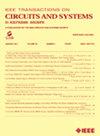源同步接口全数字宽范围去斜双边校正电路
IF 4.9
2区 工程技术
Q2 ENGINEERING, ELECTRICAL & ELECTRONIC
IEEE Transactions on Circuits and Systems II: Express Briefs
Pub Date : 2025-02-07
DOI:10.1109/TCSII.2025.3540008
引用次数: 0
摘要
本文介绍了一种采用双边校正方案的全数字宽范围去斜电路,用于源同步接口,实现数据与时钟的精确同步。该方案不仅对数据和时钟信号的上升沿进行了对齐,而且对多位并行数据的下降沿位置偏移进行了补偿,解决了由于歪斜和脉宽失真导致的数据有效窗口缩小的问题。采用两级数控延迟线实现大范围的去偏。采用半周期延迟线法进行时钟占空比校正,同时产生90度相移,优化采样余量。测试芯片采用180nm CMOS工艺制作,每条数据通路占用0.0453mm2。芯片测试结果表明,当输入时钟模式数据信号占空比在28% ~ 65%范围内时,数据与时钟之间的时序偏差减小到28ps以内,脉宽校正误差小于1.7%。本文章由计算机程序翻译,如有差异,请以英文原文为准。
An All-Digital and Wide-Range De-Skew Circuit With Dual-Edge Correction Scheme for Source Synchronous Interfaces
This brief presents an all-digital and wide-range de-skew circuit with dual-edge correction scheme for source synchronous interfaces to achieve precise synchronization between data and clock. The proposed scheme not only aligns the rising edges of data and clock signals, but also compensates for the falling edge position offsets of multi-bit parallel data, which can address the narrowing of data valid window caused by skew and pulse-width distortion. A two-stage digitally-controlled delay line is utilized to achieve wide-range de-skew. Besides, a half-cycle delay line method is adopted for clock duty-cycle correction, while generating a 90-degree phase shift to optimize the sampling margin. The test chip is fabricated in 180nm CMOS process, and each data path with the proposed de-skew circuit occupies 0.0453mm2. The chip testing results show that the timing skew between data and clock is reduced to within 28ps, and the pulse-width correction error is less than 1.7% when the duty cycle of the input clock pattern data signal ranges from 28% to 65%.
求助全文
通过发布文献求助,成功后即可免费获取论文全文。
去求助
来源期刊
CiteScore
7.90
自引率
20.50%
发文量
883
审稿时长
3.0 months
期刊介绍:
TCAS II publishes brief papers in the field specified by the theory, analysis, design, and practical implementations of circuits, and the application of circuit techniques to systems and to signal processing. Included is the whole spectrum from basic scientific theory to industrial applications. The field of interest covered includes:
Circuits: Analog, Digital and Mixed Signal Circuits and Systems
Nonlinear Circuits and Systems, Integrated Sensors, MEMS and Systems on Chip, Nanoscale Circuits and Systems, Optoelectronic
Circuits and Systems, Power Electronics and Systems
Software for Analog-and-Logic Circuits and Systems
Control aspects of Circuits and Systems.

 求助内容:
求助内容: 应助结果提醒方式:
应助结果提醒方式:


